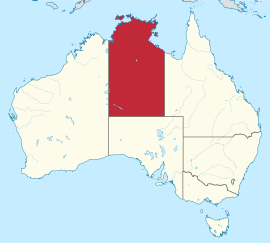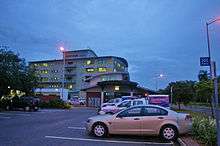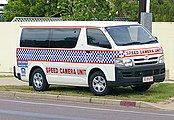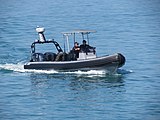Northern Territory Police
The Northern Territory Police Force is the police body that has legal jurisdiction over the Northern Territory of Australia. This police service has 1,537 police members (as at 31 July 2019) made up of 79 senior sergeants, 228 sergeants, 839 constables, 208 auxiliaries, and 73 Aboriginal Community Police Officers. The rest of the positions are members of commissioned rank and inoperative positions (as of 31 July 2019). It also has a civilian staff working across the NT Police, Fire and Emergency Services.
| Northern Territory Police Force | |
|---|---|
 Badge of the Northern Territory Police | |
 Flag of the Northern Territory Police | |
| Abbreviation | NT Police |
| Motto | To Serve and Protect |
| Agency overview | |
| Formed | 1911 |
| Jurisdictional structure | |
| Operations jurisdiction | Northern Territory, Australia |
 | |
| Northern Territory Police jurisdiction | |
| Size | 1,349,129 square kilometres (333,377,000 acres; 134,912,900 ha) |
| Population | 229,700 (2010) |
| Governing body | Government of Northern Territory |
| General nature | |
| Operational structure | |
| Headquarters | Peter McAulay Centre, Berrimah Darwin, NT 12°27′40″S 130°50′22″E |
| Sworn officers | 1,537 (June 2019) |
| Minister responsible |
|
| Agency executive |
|
| Units | List
|
| Service areas | 3
|
| Facilities | |
| Stations | 70 police stations and shopfronts |
| Website | |
| www | |
Police in the Northern Territory are part of a Tri-Service: the Northern Territory Police, Fire and Emergency Services with the Commissioner of Police as the CEO of the Tri-Service. Sworn police officers can be required to serve anywhere where a police presence is required in the Northern Territory including remote Aboriginal communities in Arnhem Land and outback Northern Territory.
History
The Northern Territory Police traces its roots back to the South Australian Mounted Police from 1870 when Inspector Paul Foelsche and six other police officers arrived in the Territory. A small rural constabulary (part-time force) had existed earlier but was disbanded. The Native Police Corps was formed in 1884. Their role was mostly as a security force to protect the early inhabitants of the Northern Territory than as a police force. The current NTP came into existence in 1911. In 1931, the two Territories Central and Northern became the Northern Territory of Australia and the authority of the Commissioner of Police was established in the Administrator of the Northern Territory, in Darwin.
In December 1869, the governor commissioned Paul Foelsche, a Corporal in the SA Mounted Police stationed at Strathalbyn, to be the first sub-inspector of police at Palmerston. He sailed for Darwin soon afterwards. The police uniform then worn in the Territory was the same as that worn in South Australia. It consisted of a short cut-away blue serge tunic with nine regulation buttons, silver twisted cord shoulder knots, black braid on the sleeves and silver chevrons for non-commissioned officers. The riding breeches were dark blue corkscrew serge with a white stripe.
The first firearms were a Schneider rifle or carbine, calibre .577. These were the first breech loaded rifles used in the British Army, and the original cartridges had a cardboard case. Later Martini-Henry rifles were used, and Webley revolvers were issued. Like their predecessors, the Rural Constabulary at Escape Cliffs, the first detachment of police at Palmerston had as their first responsibility the maintenance of law and order in the community.
With the discovery of gold near Pine Creek in 1872 the police found themselves with never a dull moment. Stations were established at Adelaide River, Yam Creek, Pine Creek, Roper River and later at Daly River. The first police fatality occurred in 1872 when Mounted Constable Davis, a noted swimmer, disobeyed a local Standing Order and had a dip in the sea. He was killed by a crocodile. Darwin's first police station was constructed of poles and plaster measuring 6.1 metres (20 ft) by 3.7 metres (12 ft). The inspector lived nearby in three rooms. A small stone building with two cells was the accommodation for those in custody. These are now incorporated in the Administrator's offices on the Esplanade.
In Central Australia the police were part of the South Australian Mounted Police. Mounted Constable Shirley was the first mounted trooper in charge at Alice Springs (first called Stuart). At one time there were two Commissioners of Police in the Northern Territory: one for the Territory of North Australia and one for the Territory of Central Australia. In 1931, the two Territories became the Northern Territory of Australia and the authority of the Commissioner of Police was vested in the Administrator of the Northern Territory, in Darwin.
On 1 July 1964, Clive William Graham, a police officer of long standing in the Territory, was appointed as Commissioner and the force as a whole was administered as part of the Public Service of the Northern Territory. In recent years, various cases have made national and international headlines: the end of the Petrov Affair occurred in Darwin; the 1968 month-long bush search for Larry-Boy who murdered his wife and seriously injured a stockman at Elsey Station; and the 1971 attempted hijack of a plane at Alice Springs airport in which a Territory police officer, who was badly wounded, displayed great heroism. Events connected with search and rescue operations at sea, in swamps and the desert have also made the news.[2] Auxiliaries and Aboriginal Community Police Officers. The Joint Emergency Services Communications Centre in Darwin has instant contact with all stations, vehicles, aircraft and vessels and provides for the Police, Fire, Emergency Services and St John Ambulance Service.
Recent history
In 1955, there were 80 police officers. As of June 2011, the number of sworn Police, Auxiliaries and Aboriginal Community Police Officers in the service was 1,381.[3]
In 1989, the Northern Territory Police, Fire and Emergency Services were joined to become a Tri-Service. The Commissioner of Police also becoming the Chief Executive Officer for the Fire and Rescue Service and the Emergency Services.
In July 2019, Commissioner Reece Kershaw was appointed Commissioner of the Australian Federal Police, after being at the helm of NT Police for five years.[4]
Organisational structure
- Commissioner: Jamie Chalker
- Deputy Commissioner, Operations: Michael Murphy
- Deputy Commissioner, Investigations and Capability: Michael White (Acting)
- Assistant Commissioner, Crime and Integrity: Nick Anticich
- Assistant Commissioner, Darwin and Support: Vacant
- Assistant Commissioner, Regional Operations: Narelle Beer
- Chief Fire Officer – NT Fire and Rescue Service: Mark Spain
- Chief Officer – NT Emergency Service: Fleur O’Connor
- Executive Director – NT Fire, Rescue and Emergency Services: David Willing
- Chief of Staff: James J O'Brien
Commissioners
| Rank | Name | Post-nominals | Term began | Term ended | Notes |
|---|---|---|---|---|---|
| Commissioner of the Northern Territory Police | |||||
| Paul Heinrich Matthias Foelsche | 1870 | 1904 | |||
| Nicholas John Waters | 1904 | 1923 | |||
| Major | George Vernon Dudley | 1924 | 1927 | ||
| The Office of Commissioner was held by the Government Resident, a position now known as the Administrator of the Northern Territory | |||||
| Clive William Graham | 1964 | 1966 | |||
| Sydney James Bowie | 1966 | 1967 | |||
| William James McLaren | 1967 | 1978 | |||
| Commissioner | Peter McAulay | AO, QPM | 1978 | 1988 | |
| Commissioner | Mick Palmer | AO, APM | 1988 | 1994 | |
| Brian Charles Bates | 1994 | 2001 | |||
| Paul Cameron White | 2001 | 2009 | |||
| John McRoberts | 2009 | 2015 | [5] | ||
| Reece Kershaw | 2015 | 2019 | |||
| Jamie Chalker | 2019 | present | |||
Organisation


The headquarters of the Northern Territory Police is located at NAB House on Smith Street, Darwin. The Department of Police, Fire and Emergency Services is administered from the Peter McAulay Centre in Berrimah. The Northern Territory Police maintains 63 local police stations and 5 police shopfronts coordinated by their respective Local Area Commands.[3]
A number of specialist units have been established, including the Territory Response Group, Accident Investigation Unit, Computer Crime Unit, Drug Intelligence Unit, Substance Abuse Intelligence Desk (SAID), Indigenous Development Unit, Highway Patrol Unit, Missing Persons Unit, Remote Area Traffic Patrol Unit and Air Support Unit.
Traffic enforcement/crash investigation
After a record road toll of 75 in the year 2008, there are currently 8 members in the Darwin region responsible for traffic enforcement, major crash investigation, special events, traffic campaigns, escort duties and general duties taskings as required.
Air Wing
The NT Police Air Wing was formed in 1979 with bases in Darwin and Alice Springs, operating two fixed wing aircraft. The area of operation covers 1,346,200 square kilometres (332,700,000 acres), being some 1,610 kilometres (1,000 mi) north to the south and 934 kilometres (580 mi) east to the west. This around one sixth of the Australian landmass, but is very remote, having less than 200,000 residents (1% of the national population). The commonwealth government funded an extra two planes to be based in Darwin. The planes were later handed back due to lack of money.[6]
CitySafe
The CitySafe & Licensing Patrol Unit was forged during New Year's Eve celebrations in 2008/2009. CitySafe was officially launched by the NT Chief Minister Paul Henderson on 25 February 2009.[7] After this was deemed a success, NT police were looking at establishing a specialist licensing enforcement unit in 2010.[8]
Bottle Shop Security
Police Auxiliaries now guard bottle shops in Katherine, Tennant Creek and Alice Springs. They are called liquor inspectors.[9]
Firearms and equipment
Officers now carry the Glock 22 or the Glock 27 .40-calibre pistol for plain clothes members. Other weapons used in the Northern Territory Police include the AR-15 semi-automatic rifle which is used by specialist groups and specifically trained members in rural areas. Officers also carry Remington model 870 pump action shotgun and Remington model 700 (.308) bolt-action rifle, which is gradually replacing the older BRNO model 601 bolt-action rifles in the same calibre. The NT Police introduced the model X-26 Advanced TASER into operational service for General Duties members in February 2008, distributing 74 units. The X26 Taser has now been replaced with the Taser X-2.[10] as a less lethal force option available to each frontline patrol.
Restraints used are Mk-IV and V Saf-Lok Handcuffs and Flexi-cuffs. Mk-6 and Mk-9 First Defense Oleoresin Capsicum (OC) Spray are also general issue.
Vehicles
The Northern Territory Police mostly use LAC response vehicles include Ford Falcon sedans, Holden VE Commodore[11] and Toyota Hilux dual cab utes as caged vehicles (4x4 and 2WD) Turbo diesel.[12] Specialist vehicles include the Toyota Land Cruiser 4WD.
Highway Patrol vehicles usually consist of a combination of marked and unmarked Holden VY SS Commodores and Ford Falcon XR6II. Other specialist sections and units use a variety of police vehicles including Isuzu trucks, and fixed wing Pilatus PC-12 aeroplanes.
The Northern Territory police recently acquired Kia stingers to add to their Road Policing Command fleet.
 Toyota Hilux
Toyota Hilux Mobile Speed Camera unit
Mobile Speed Camera unit Patrol boat
Patrol boat
Officers killed on duty
- 7 November 1883, Mounted Constable John Shirley, aged 27 years from dehydration while searching for men who had murdered a man at Lawson's Creek.[13]
- 1 August 1933, mounted constable Albert Stewart McColl was speared to death at Woodah Island in Arnhem Land.[13]
- 17 August 1948, Constable Maxwell Gilbert, aged 27 years when the vehicle he was driving overturned just north of Wauchope. He was escorting a prisoner to Alice Springs.[13]
- 9 June 1952, constable William Bryan Condon was shot twice after confronting a gunman.[13]
- 16 June 1967, inspector Louis Hook died from extensive injuries from a rollover near Pine Creek.[13]
- 9 June 1970, sergeant Colin Eckert was killed in a head-on collision in Katherine.[13]
- 11 December 1981, senior constable Allen Price aged 44 years died of a heart attack while attempting to stop a disturbance in Mataranka.[13]
- 29 January 1984, detective sergeant Ian Bradford died when the police vehicle he was a passenger in went over the edge of the wharf in Darwin.[13]
- 3 August 1999, Brevet sergeant Glen Huitson was killed in a gun battle with bushman Rodney Ansell on the Stuart Highway.[13]
References
- "A message from the Acting Commissioner of Police Police". Northern Territory Police. 15 August 2019. Retrieved 29 October 2019.
- "In the Line of Duty". Australian Federal Police. Retrieved 24 March 2008.
- Northern Territory Police, Fire and Emergency Services Annual Report 2010–11, Northern Territory Police, Fire and Emergency Services, June 2011.
- James, Felicity (24 July 2019). "Australia's new police commissioner: Who is Reece Kershaw?". ABC News. Australian Broadcasting Corporation. Retrieved 29 October 2019.
- "NT Police Commissioner John McRoberts forced out after investigation into a conflict of interest". NT News. 14 January 2015. Retrieved 14 January 2015.
- "Secret documents show how far NT Police are going to save millions of dollars and meet budget cuts". www.ntnews.com.au. 10 August 2018.(subscription required)
- "CitySafe Night Patrol on the Beat in the City" Archived 17 September 2009 at the Wayback Machine NT Government, 2009. (deadurl)
- Trifonoff, Allan; et al. "Liquor licensing legislation in Australia: Part 3: Police expectations and experiences" (PDF). An examination of Liquor Licensing Legislation in Australia as at December 2010. Commissioned by the Intergovernmental Committee on Drugs through the National Drug Strategy Cost Shared Funding Model. Retrieved 24 October 2019. Cite journal requires
|journal=(help) - "Auxiliary Police Officer". www.pfes.nt.gov.au. Archived from the original on 31 July 2019.
- "Northern Territory Police introduce TASER". Northern Territory Police, Fire and Emergency Services. Retrieved 24 March 2008.
- "Northern Territory Police vehicles". Australian Police Vehicles Website. Retrieved 24 March 2008.
- "Northern Territory Police assorted vehicles". Australian Police Cars. Retrieved 24 March 2008.
- "National Memorial Honours Our Police". Northern Territory Government. Retrieved 24 March 2008.
External links
Further reading
- Debnam, Lawrie.(1990) Men of the Northern Territory Police 1870–1914 : who they were and where they were Elizabeth, S. Aust. L. Debnam. ISBN 0-949124-62-1